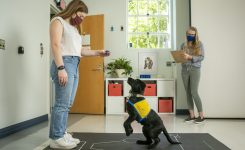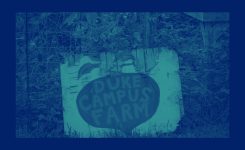Features
Creating a Positive Workforce Experience
Creating a Positive Workforce Experience
Through benefits and community, ‘Duke University People’ prioritized
In the early 1990s, Sara-Jane Raines came to work at Duke each day hiding her sexual orientation.
Raines, a Duke alumna and officer with the Duke University Police Department, kept her true self hidden during the time. She heard jokes about gay people, saw defaced LGBTQ+ event posters, and felt disappointed that Duke University Chapel did not allow same-sex commitment ceremonies. Fear of repercussions kept Raines in the closet.
But in 1995, when then-Duke University President Nannerl O. Keohane made Duke the first southern university to extend medical insurance and other benefits to partners of LGBTQ+ employees, Raines, and others in her situation, felt that they belonged at Duke. Soon after, she felt comfortable to come out to colleagues, who, she said, were unfazed.
“Duke was the safe haven for me and my partner and for the other employees that I knew were gay,” said Raines, who has been married since 2015 to Deb Kinney, who also works at Duke. “It was really important that Duke stood up for us.”
Duke University Police Department’s Sara-Jane Raines, right, has been married to fellow Duke staff member Deb Kinney, left, since 2015. Courtesy of Sara-Jane Raines. At left: in the 1980s, the Blueprint relayed information and fun features to Duke employees. Image: Duke University Archives.
Duke University President Terry Sanford attends a meeting in the Allen Building. Photo: Duke University Archives.
The extension of same-sex partner benefits made news headlines and came during an era when Duke’s relationship with its employees underwent a dramatic shift. From the 1970s into the early 2000s, Duke enhanced benefits and tried to build a climate where all staff and faculty felt valued and included.
Terry Sanford, Duke University’s President from 1970 to 1985, said in a 1984 address to faculty that if Duke aspired to be “an institution of freedom and enlightenment,” it must reflect that in how it treats its employees.
“Every person who works for Duke is important to Duke,” Sanford said. “They are all Duke University people.”
The 1970s saw Duke celebrate its 50th anniversary, raise its minimum wage, pilot a financial guidance program for employees nearing retirement, and reclassify 9,000 employees into 24 “job families” for bi-weekly paid staff and 14 “job families” for monthly paid staff, creating clear lines for advancement.
William R. Linke, Director of Personnel, issued Duke’s inaugural annual report in 1971 on equal opportunity employment, noting an increase of 1.1% minority group employment compared to the previous year. He shared that, at the time, minority employees comprised 28.5% of the workforce.
“This report indicates that some progress has been made; however, we must continue to increase our employment and upgrade of minority groups and females if we are to correct the underutilization of these groups,” he said in a memo to department heads.
“You cannot have any weak spots in a great institution,” Director of Duke Human Resources Toby Kahr said in a 1986 Duke Chronicle story about expanding employee benefits. “Duke should be an excellent place to work so that we can get the very best people.”
Duke prioritized building a shared culture among a large, diverse workforce, which, by the early 1990s, had grown to nearly 20,000 people. During the 1980s and 1990s, a variety of employee events gained popularity. These included tailgate parties preceding Duke Football games, festive holiday turkey trots with actual turkeys as prizes, commemorations for career service milestones, and celebrations of “Duke Employee Week.”

“Employee Day” at Duke in April 1984 featured food, music, and balloons. Photo: Duke University Archives.
Duke's “Employee Day” in April 1984 was part of a larger movement of building a sense of community among Duke's growing workforce. Photo: Duke University Archives.
Kim Harris, Duke’s Associate Vice Provost and Director of Academic Human Resources Services who joined Duke in 1978, remembers attending employee events, such as art exhibits, talent shows and football tailgates. She said that the experiences held significance for her because they forged meaningful connections between work and home, accomplished by involving families in campus activities.
“Those kind of things started bringing employees together and giving everyone a sense that Duke is not just a place that they went to work, but it was also a community,” she said.
In the 1980s, Duke produced monthly employee-focused newspapers such as Blueprint for Duke University staff to feature employees and enhance communication about benefits and policies. A 1986 Blueprint story featured Secretary Doris Ralston’s memories of four decades at Duke, including fun student encounters and big 5-cent hot dogs available on campus.
“The longer you are here,” Ralston, who worked in the Department of Political Science, said in the story, “the more difficult it is to pick out what is most important to you.”
After 35 years with Duke’s police department, Raines – now the Assistant Chief of Police – relates. Over the years, she’s had other opportunities, but with benefits that fit her life, and lasting connections with colleagues, Duke is where she’s meant to be.
“Duke has felt like my home,” Raines said. “I think that’s why I have such an incredible sense of loyalty to this place. It’s the place that saw me and heard me and let me be here and contribute to the community.”
This story is part of Working@Duke's celebration of Duke's Centennial year. Working@Duke is highlighting historical workforce issues and showcasing employees in a special series through 2024.
Reported and Written by Working@Duke Staff.








